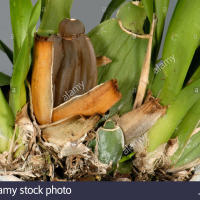Phytophthora trunk rot
Phytophthora cactorum
Phytophthora cactorum:
Phytophthora cactorum is a soil-borne pathogen that causes crown and root rot in various fruit and ornamental plants. This pathogen affects a broad range of hosts, including strawberries, raspberries, apples, ornamental trees, and shrubs. Here's an informative description of Phytophthora cactorum, including its appearance, identification, and management:
Appearance:
Crown and Root Symptoms:
- Crown Rot: Infected plants may exhibit symptoms of crown rot, where the base of the stem near the soil line becomes discolored, often turning brown or black.
- Root Rot: The pathogen infects the roots, causing rotting and decay. Healthy roots may appear water-soaked and turn dark as the disease progresses.
Above-Ground Symptoms:
- Wilting and Decline: Infected plants may show wilting and overall decline, as the root and crown damage compromise the plant's ability to take up water and nutrients.
- Leaf Discoloration: Foliage may exhibit yellowing or browning, starting from the lower leaves and progressing upwards.
- Dieback: In severe cases, dieback of branches and shoots may occur, leading to stunted growth and reduced yields.
Identification:
- Crown and Root Examination: Carefully inspect the crown and roots of affected plants for signs of rotting and discoloration.
- Symptomatic Foliage: Look for yellowing or browning of leaves, wilting, and dieback in the upper parts of the plant.
- Soil Sampling: Conduct soil tests to detect the presence of Phytophthora cactorum in the planting area.
Management:
-
Well-Drained Soil:
- Improve Drainage: Ensure proper soil drainage to reduce the risk of waterlogged conditions that favor Phytophthora infections.
-
Resistant Varieties:
- Plant Resistant Cultivars: When available, choose plant varieties or cultivars that are resistant or tolerant to Phytophthora cactorum.
-
Avoid Overhead Irrigation:
- Drip Irrigation: Use drip irrigation instead of overhead irrigation to minimize soil splash and reduce the spread of the pathogen.
-
Soil Amendments:
- Organic Matter: Incorporate well-rotted organic matter into the soil to improve its structure and drainage.
-
Fungicide Application:
- Fungicidal Treatments: In commercial settings, application of appropriate fungicides may be considered. Consult with local agricultural experts for recommended products and application schedules.
-
Sanitation:
- Remove Infected Plants: Promptly remove and destroy infected plants to prevent the further spread of the pathogen.
- Clean Equipment: Disinfect gardening tools and equipment to avoid transmitting the pathogen.
-
Crop Rotation:
- Rotate Crops: Implement a crop rotation strategy to reduce the buildup of Phytophthora cactorum in the soil.
-
Monitoring:
- Regular Inspection: Periodically inspect plants for symptoms of crown and root rot, especially during wet conditions that favor disease development.









Plant Protection Products
- N/A
- N/A
- N/A
- N/A
- N/A
- N/A
- N/A
- N/A
- N/A
- N/A
- N/A
- N/A
- N/A
- N/A
- N/A
- N/A
- N/A
- N/A
- N/A
- N/A
- N/A